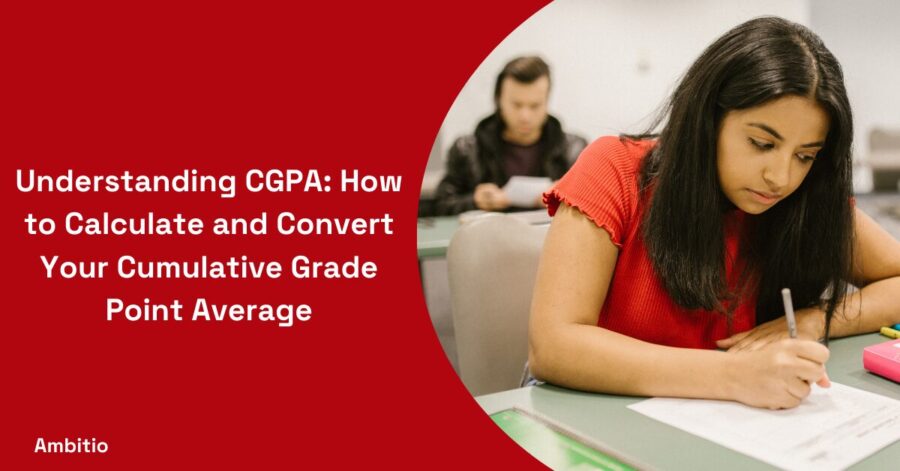13 December 2024
6 minutes read
Understanding CGPA: How to Calculate and Convert Your Cumulative Grade Point Average

CGPA, or Cumulative Grade Point Average, is a pivotal metric in educational institutions for gauging a student’s academic performance. Unlike the traditional percentage-based system, CGPA offers a more nuanced and balanced evaluation of a student’s capabilities.
What is CGPA? Understanding its Full Form and Significance
CGPA stands for Cumulative Grade Point Average. This grading system represents the average of grade points obtained in all subjects, excluding additional subjects as per the scheme of studies.
The full form of CGPA itself highlights its role as a cumulative measure, reflecting a student’s performance over an entire course of study rather than in individual exams or semesters.
The Evolution of Grading Systems and CGPA’s Role
Grading systems have evolved significantly over the years. Traditional methods focused on percentages, which provided a straightforward but often limited understanding of a student’s performance.
The introduction of the CGPA system marked a shift towards a more holistic assessment method. CGPA takes into account the grades earned across various subjects and semesters, offering a more comprehensive view of a student’s academic abilities.
This system is especially beneficial in higher education, where the diversity of subjects and the complexity of coursework make a singular percentage score insufficient for a complete evaluation.
Calculating Your CGPA: A Step-by-Step Guide
Calculating your Cumulative Grade Point Average (CGPA) may seem daunting at first, but it’s quite straightforward once you understand the process. Here’s a step-by-step guide to help you calculate your CGPA accurately:
Step 1: Understand Your Grading Scale
- Identify the Grading Scale: Different institutions use different grading scales. Familiarize yourself with the scale your institution uses – whether it’s a 10-point scale, a 4-point scale, or another format.
- Know the Grade Points: Understand the points assigned to each grade. For instance, in a 10-point scale, an ‘A’ might correspond to 10 points, a ‘B’ to 9, and so on.
Step 2: Gather Your Grades
- Collect Your Grades: Compile a list of your grades for all the subjects or courses you have taken. Include all semesters or years that contribute to your CGPA.
- Account for Credit Hours: If your institution uses credit hours, note down the credit hours for each subject alongside the grades.
Step 3: Convert Grades to Grade Points
- Apply the Grading Scale: Convert each of your grades into the corresponding grade points as per the scale used by your institution.
- For Credit-based Systems: If your system uses credit hours, multiply the grade points for each subject by the respective credit hours. This gives you the weighted grade points for each subject.
Step 4: Calculate Total Points and Total Credit Hours
- Sum Up Grade Points: Add all the grade points (or weighted grade points, if applicable) together to get a total.
- Total Credit Hours: If using a credit system, also sum up all the credit hours.
Step 5: Divide and Calculate CGPA
- Divide for Average: Divide the total grade points by the total number of subjects (or total credit hours, if applicable).
- The result is Your CGPA: The quotient will be your CGPA. Round off the number if required, as per your institution’s guidelines.
Step 6: Regular Updates and Tracking
- Update Regularly: After the completion of each semester or academic year, update your CGPA calculation to reflect your current academic standing.
- Track Your Performance: Regularly calculating your CGPA can help you track your academic performance and set goals for future semesters.
Additional Tips:
- Accuracy is Key: Ensure all grades and credit hours are accurately recorded for precise calculation.
- Institution-Specific Policies: Be aware of any specific rules your institution might have regarding CGPA calculation, such as the exclusion of certain courses or the inclusion of additional subjects.
- Use Tools When Necessary: Don’t hesitate to use online CGPA calculators or spreadsheets to simplify the calculation process, especially when dealing with numerous subjects or complex credit hour systems.
By following these steps, you can calculate your CGPA effectively. This calculation not only provides insight into your overall academic performance but also helps you plan your academic trajectory and identify areas for improvement.
From CGPA to Percentage and Back: Conversion Calculators and Techniques
Convert CGPA to Percentage: Understanding the 9.5 Multiplication Factor
In many educational systems, particularly in India, there’s a standardized method to convert CGPA to percentage – multiplying the CGPA score by 9.5.
Decoding the 9.5 Multiplication Factor
This 9.5 multiplication factor is based on the top score (10) and the maximum percentage (95%). This method assumes that the highest possible CGPA (10) equates to the highest percentage score (95%), thus creating a linear scale for conversion.
By multiplying your CGPA by 9.5, you get an equivalent percentage that approximates your overall academic performance in a percentage format. While this conversion is widely accepted, it’s crucial to remember that it may not align precisely with all grading systems, and discrepancies can occur.
The Reverse Calculation: Converting Percentage to CGPA
Converting a percentage to CGPA involves reversing the earlier-mentioned process.
Steps to Convert Percentage to CGPA
To perform this conversion, divide the percentage score by 9.5. This method translates the percentage into a CGPA format, allowing for a standardized comparison across different grading systems.
This conversion is particularly useful for students transitioning between educational systems or institutions that use different evaluation metrics. However, like any conversion, this too has its limitations and should be used as a general guide rather than an absolute measure.
Tools and Converters for Accurate CGPA Calculation
In the digital age, numerous tools and converters are available to simplify the process of calculating your Cumulative Grade Point Average (CGPA). These resources can help ensure accuracy, save time, and provide a clear understanding of your academic performance. Below, we explore some of the most useful tools and converters for accurate CGPA calculation.
Online CGPA Calculators
- Web-based CGPA Calculators: These are user-friendly websites where you simply enter your grades, and the calculator does the rest. They are ideal for quick calculations and are often tailored to specific educational institutions’ grading systems.
- Customizable Features: Some advanced calculators offer customizable options, allowing you to input specific grade points and credit hours, catering to different grading scales globally.
Spreadsheet Programs
- Excel and Google Sheets: These versatile programs can be used to create a custom CGPA calculator. You can input your grades, set up formulas to convert them to grade points and calculate the weighted average.
- Templates: Many pre-made templates are available online which can be downloaded and customized as per individual requirements.
Mobile Apps
- Dedicated CGPA Calculator Apps: There are numerous mobile apps available for both iOS and Android devices. These apps often come with additional features like saving your grades semester-wise and tracking your academic progress over time.
- User-friendly Interface: The advantage of mobile apps is their convenience and ease of use, allowing students to calculate and track their CGPA on the go.
Conversion Charts and Tables
- Printable Conversion Charts: These are useful for quick reference, especially when converting percentages to CGPA or vice versa. They are particularly handy during examinations or when planning for future academic endeavors.
- Customized for Different Systems: Many educational institutions provide their own conversion charts, which are tailored to their specific grading system.
Educational Institution Portals
- University/College Websites: Some educational institutions offer CGPA calculators on their websites. These are specifically designed to align with the institution’s grading policies and offer the most accurate calculations for their students.
- Integrated Student Information Systems: These platforms not only calculate CGPA but also provide comprehensive academic records, including semester-wise grades and credits.
Custom Scripting and Software
- Programming Solutions: For those with programming knowledge, writing a custom script in languages like Python, Java, or JavaScript to calculate CGPA offers a personalized and flexible tool.
- Specialized Software: There are also specialized academic software programs that can calculate CGPA, often used by educational institutions for managing student records.
Additional Tools
- Online Forums and Academic Communities: These platforms often share insights and tools for CGPA calculation. They are also excellent resources for getting your queries answered.
- Educational Blogs and Tutorials: Many educational websites provide step-by-step guides and video tutorials on how to calculate CGPA, making the process easier to understand for everyone.
Using these tools and converters can greatly enhance the accuracy and efficiency of calculating your CGPA. Whether it’s a simple online calculator for quick checks or a comprehensive software program for detailed academic tracking, there’s a tool out there to suit every student’s needs. It’s important to choose a method that aligns with your educational system’s guidelines and your personal preferences for the best results.
Understanding the 4.0 Grading Scale and Its Conversion to CGPA
In some countries, particularly the United States, the 4.0 grading scale is prevalent. Converting this to CGPA requires an understanding of the differences between these two systems.
Navigating the Conversion from a 4.0 Scale to CGPA
The 4.0 grading scale is another method of evaluating academic performance, where each grade corresponds to a number on a scale of 0 to 4. To convert this to a CGPA on a 10-point scale, one must multiply the 4.0 scale GPA by 2.5.
This conversion allows for an equivalent understanding of academic performance across different grading systems. However, it’s important to recognize the contextual differences in grading criteria and course complexity when making these conversions.
Conclusion
CGPA calculation varies significantly based on the educational grading system. In some systems, the grades in major subjects carry more weight, while in others, all subjects contribute equally to the CGPA. Understanding these nuances is crucial for accurately assessing academic performance.
FAQs
Q1: What is the full form of CGPA?
The full form of CGPA is Cumulative Grade Point Average.
Q2: How do I calculate my CGPA?
Add the grade points of all subjects, then divide by the total number of subjects.
Q3: How can I convert my CGPA to a percentage?
Multiply your CGPA by 9.5 to get the equivalent percentage.
Q4: Is the CGPA to percentage conversion accurate?
It gives a general idea, but accuracy varies based on the institution’s grading system.
Q5: Can I convert my percentage to CGPA?
Yes, divide your percentage by 9.5 to get your CGPA.

You can study at top universities worldwide!
Get expert tips and tricks to get into top universities with a free expert session.
Book Your Free 30-Minute Session Now! Book a call now




























